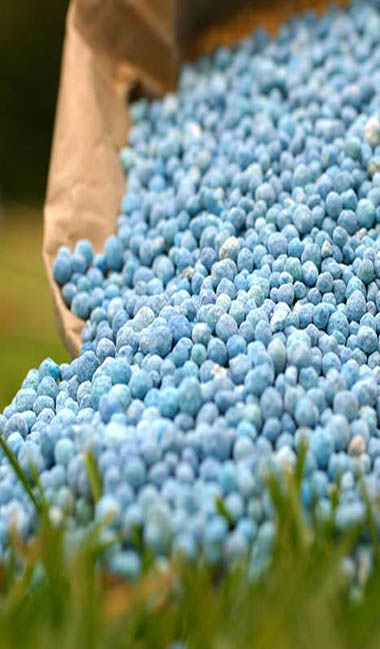Fertilizer

Triple Superphosphate
Triple superphosphate (TSP) was one of the first high analysis P fertilizers that became widely used in the 20th cen- tury. Technically, it is known as calcium dihydrogen phosphate and as monocalcium phosphate, it is an excellent P source, but its use has declined as other P fertilizers have become more popular.
Production
The concept of TSP production is relatively simple. Non-granular TSP is commonly produced by reacting finely ground phosphate rock with liquid phosphoric acid in a cone-type mixer. Granular TSP is made similarly, but the resulting slurry is sprayed as a coating onto small particles to build granules of the desired size. The product from both production methods can cure for several weeks as the chemical reactions are slowly completed. The chemistry and process of the reaction will vary somewhat depending on the properties of the phosphate rock.
Agricultural Use
TSP has several agronomic advantages that made it such a popular P source for many years. It has the highest P content of dry fertilizers that do not contain N. Over 90% of the total P in TSP is water soluble, so it becomes rap- idly available for plant uptake. As soil moisture dissolves the granule, the concentrated soil solution becomes acidic. TSP also contains 15% calcium (Ca), providing an additional plant nutrient.
A major use of TSP is in situations where several solid fertilizers are blended together for broadcasting on the soil surface or for application in a concentrated band beneath the surface. It is also desirable for fertilization of leguminous crops, such as alfalfa or beans, where no additional N fertilization is needed to supplement biological N fixation.
NPK
NPK fertilizer is primarily composed of three main elements: Nitrogen (N), Phosphorus (P), and Potassium (K), each of these being essential in plant nutrition.
. Among other benefits, Nitrogen helps plants grow quickly, while also increasing the production of seed and fruit, and bettering the quality of leaf and forage crops. Nitrogen is also a component of chlorophyll, the substance that gives plants their green color, and aids in photosynthesis.
Phosphorus, also a key player in the photosynthesis process, plays a vital role in a variety of the things needed by plants. Phosphorus supports the formation of oils, sugars, and starches. The transformation of solar energy into chemical energy is also aided by phosphorus, as well as is development of the plant, and the ability to withstand stress. Additionally, phosphorus encourages the growth of roots, and promotes blooming.
Potassium, the third essential nutrient plants demand, assists in photosynthesis, fruit quality, the building of protein, and the reduction of disease.
SSP
Single superphosphate (SSP) was the first commercial mineral fertilizer and it led to the development of the modern plant nutrient industry. This material was once the most commonly used fertilizer, but other phosphorus (P) fertilizers have largely replaced SSP because of its relatively low P content.
Production
The modern fertilizer industry was launched in the 1840s with discovery that the addition of sulfuric acid to naturally oc- curring phosphate produced an excellent soluble fertilizer, given the name superphosphate. Ground animal bones were first used in this reaction, but natural deposits of rock phosphate (apatite) soon replaced the limited supply of bones. Making SSP is like what naturally occurs with bones or apatite in acid soils. The basic technique has changed very little in the past century. Ground phosphate rock is reacted with sulfuric acid to form a semi-solid which cool for several hours in a den. The plastic-like material is then conveyed to a storage pile for several weeks of additional curing. The hardened material is then milled and screened to the appropriate particle size or granulated. The general chemical reaction is:
Ca3(PO4)2 [rock phosphate] + 2 H2SO4 [sulfuric acid] → Ca(H2PO4)2 [monocalcium phosphate] + 2 CaSO4 [gypsum]
SSP can easily be produced on a small scale to meet regional needs. Since SSP contains both monocalcium phosphate (MCP, also called calcium dihydrogen phosphate) and gypsum, there are no issues with phosphogypsum by-product dis- posal as occurs with the manufacture of other common P fertilizers.
SSP is also known as ordinary superphosphate and normal superphosphate. It is sometimes confused with triple super- phosphate (TSP) production, which is made by reacting rock phosphate with phosphoric acid.
Agricultural Use
SSP is an excellent source of three plant nutrients. The P component reacts in soil similarly to other soluble fertilizers. The presence of both P and sulfur (S) in SSP can be an agronomic advantage where both nutrients are deficient. In agronomic studies where SSP is demonstrated to be superior to other P fertilizers, it is usually due to the S and/or Ca that it contains. When locally available, SSP has found wide-spread use for fertilizing pastures where both P and S are needed. As a source of P alone, SSP often costs more than other more concentrated fertilizers, therefore it has declined in popularity.
